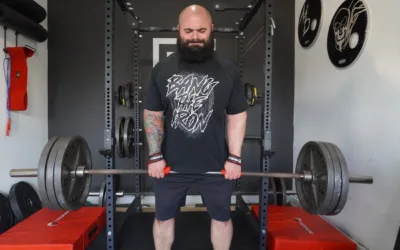What the Science Says About Creatine
Creatine supplements have a lot of science behind them. This article will cover what the science says behind this product.

Written By
Momentous
This article was written by the Momentous team, the leading provider of Informed Sport and NSF Certified for Sport performance nutrition products, which are trusted by pro athletes and teams worldwide.
What Science Says About Creatine and How to Use It
Whey protein is arguably still the king of the supplements castle, but if there was an heir apparent, it’d have to be creatine.
Why? Because 20+ years of scientific studies show that it helps power and endurance athletes alike increase their physical performance, heighten cognition, and speed recovery.
We’ll get into what the seminal studies say in a moment. But first, here’s Tim Caron, former head football strength and conditioning coach at Army West Point and founder of Allegiate, to break down what creatine actually is and what it does in the body.
What is Creatine?
“Creatine is a combination of three amino acids: glycine, arginine and methionine,” Caron said. “These form a small peptide.
Creatine creates a phosphate reservoir. The more phosphates we have circulating in our system, the more readily we can create energy.
As we exercise, we burn through glucose and ATP and start to diminish our phosphate stores. Taking creatine is a way to top the level back up so we can replenish, repair, and get more energy in our workout.
While we can get creatine from certain foods like beef, it’s more bioavailable in the form of supplemental creatine monohydrate.”

So What Does Creatine Do?
The science overwhelmingly supports what Caron is saying.
A meta-analysis released via the Journal of Strength and Conditioning Research noted an average eight percent gain in strength output during intra-workout creatine supplementation.
Two scientists concluded that after a month of taking creatine, weightlifters not only increased maximum strength output but also minimized muscle damage incurred during training. And researchers in France conducted a review of multiple studies and concluded that taking creatine daily boosts upper body power.
Time for Creatine Supplements?
So if you’ve decided to take creatine, the next question becomes, “Should I do a loading phase or just start with a daily dose?”
You could spend the next year going down a Reddit rabbit hole here, but to save you the trouble, here’s what Caron’s fellow Momentous ambassador Dave Scholz, head strength and conditioning coach for Texas Tech football recommends.
Start by loading with 20 to 25 grams of creatine per day, broken up into four or five doses. After a weeklong loading phase, then transition into a daily maintenance dose of three to five grams.

Creatine Benefits
It’s a common misconception that creatine supplementation is only for those who like to lift heavy or play strength and power sports (not least because most creatine ads feature pictures of ripped guys and girls). But the literature suggests that athletes of all kinds can benefit from taking creatine daily.
A paper published in the International Journal of Sport Nutrition and Exercise Metabolism revealed that rowers built up less lactic acid in their bloodstream during slower sessions and increased their time to exhaustion after taking creatine for just five days.
“The harder you exercise, the quicker you deplete your phosphate reservoir, which is why every athlete needs creatine,” he said. “No matter what your desired outcome is – running faster, jumping higher, lifting heavier, or cycling longer – supplemental creatine consumption can help you get there. If you’re an active human being, I’d highly recommend you try it.”
Find Your Perfect Training Plan
Sometimes all you need to reach your destination on your fitness journey is an expert guide. Look no further, we've got you covered. Browse from thousands of programs for any goal and every type of athlete.
Try any programming subscription FREE for 7 days!
Related Articles
You May Also Like...
Winter Warfare: How to Bulk Up This Season
It’s that time of the year to wreak havoc and prepare for a massive winter bulk! But wait, what is a winter bulk? What does it take, and how do we achieve it? Joseph Lucero (CSCS), owner of Harvesting Strength, is a powerlifter and strongman coach with years of...
How to Do Preacher Curls for Bigger Biceps
Who doesn’t love hitting a good biceps workout and feeling that skin-splitting pump? The preacher curl is a great exercise for bulking up your biceps, but using the EZ bar isn’t the best option for everyone. To build juicy biceps without pissing off your elbow joint,...
The Best Exercises for Developing Speed
Want to run faster? It’s not just about sprinting more. The real secret lies in the weight room. Strength training builds the raw power, stability, and mechanics that turn into explosive speed on the field or track. Here’s how to train smarter and unlock your fastest...
Winter Warfare: How to Bulk Up This Season
It’s that time of the year to wreak havoc and prepare for a massive winter bulk! But wait, what is a winter bulk? What does it take, and how do we achieve it? Joseph Lucero (CSCS), owner of Harvesting Strength, is a powerlifter and strongman coach with years of...
How to Do Preacher Curls for Bigger Biceps
Who doesn’t love hitting a good biceps workout and feeling that skin-splitting pump? The preacher curl is a great exercise for bulking up your biceps, but using the EZ bar isn’t the best option for everyone. To build juicy biceps without pissing off your elbow joint,...

Want more training content?
Subscribe
For Coaches
For Athletes
About
Support
Training Lab
Access the latest articles, reviews, and case studies from the top strength and conditioning minds in the TH Training Lab!
Made with love, sweat, protein isolate and hard work in Denver, CO
© 2024 TrainHeroic, Inc. All rights reserved.





